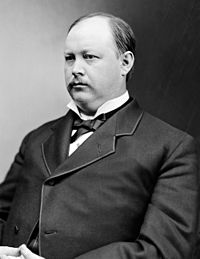Like most civic minded voting citizens I’m keeping an eye on Washington and the partisan stalemate in Congress, shaking my head and generally feeling feh about the dysfunctional state of affairs.
Today, on the eve of the Sequester, I want to recommend an interesting parable from past Congressional history as described by two excellent writers, the late historian (and personal favorite) Barbara Tuchman, and James Grant, the editor of Grant’s Interest Rate Observer. Tuchman introduced me to Thomas Reed in her book, Proud Tower, which sent me looking for more information about the man and that quest led me to Grant’s biography of Reed, Mister Speaker.

Thomas B. Reed was a congressman from Maine who was Speaker of the House from 1889 t0 1899. He was a brilliant attorney and master parlimentarian who had an immense effect on reforming the procedural rules of the House of Representatives and broke an impasse similar to the one we see today. He most significant achievement was ending an obstructionist tactic used by the minority party (Reed was a Republican confronted with a bumptious Democrat minority) called the “disappearing quorum” — something analogous to the abuse of the filibuster in the current Congress (which according to NPR has not passed a major law in over 900 days).
According to Wikipedia: “Reed sought to circumscribe the ability of the minority party to block business by way of its members refusing to answer a quorum call — which, under the rules, prevented a member from being counted as present even if they were physically in the chamber — thus forcing the House to suspend business. This is popularly called the disappearing quorum. ”
When I think of filibuster I think of a brave congressman standing on his feet reading recipes into the Congressional Record, refusing to cede the floor to anyone. Jimmy Stewart in “Mister Smith Goes to Washington” is the image in most of our minds when we think filibuster.
The record in real life for a filibuster was set by Senator Strom Thurmond in 1957 to block the Civil Rights Act of 1957. Thurmond held the floor for 24 hours and 18 minutes non-stop. I have no idea how he handled his biological needs, but the man managed to hang in there for 24 hours non-stop.
Listening to former Senator TomDaschle on NPR during my drive to New York on Tuesday, he made the strong point that the minority use of the filibuster has gotten out of control and that he’d like to see a return to the days when real dissenters stood up and actually suffered for their conscience. “I’d like to see somebody break Thurmond’s record,” he said.
What is needed is a new Thomas Reed to come in and lay down the law. Here, according to Wikipedia, is how Reed imposed what have come to be known as the “Reed Rules” and transformed Congress in the process:
“Reed’s solution was enacted on January 28, 1890, in what has popularly been called the “Battle of the Reed Rules”.[3] This came about when Democrats attempted to block the inclusion of a newly elected Republican from West Virginia, Charles Brooks Smith.[4] The motion to seat him passed by a tally of 162–1; however, at the time a quorum consisted of 165 votes, and when voting closed Democrats shouted “No quorum,” triggering a formal House quorum count. Speaker Reed began the roll call; when members who were present in the chamber refused to answer, Reed directed the Clerk to count them as present anyway.[5] Startled Democrats protested heatedly, issuing screams, threats, and insults at the Speaker. James B. McCreary, a Democrat fromKentucky, challenged Reed’s authority to count him as present; Reed replied, “The Chair is making a statement of fact that the gentleman from Kentucky is present. Does he deny it?”[5]
“Unable to deny their presence in the chamber, Democrats then tried to flee the chamber or hide under their desks, but Reed ordered the doors locked. (Texas Representative “Buck” Kilgore was able to flee by kicking his way through a door.) [6] Trapped, the Democrats tried to hide under their desks and chairs; Reed marked them present anyway.
“The conflict over parliamentary procedure lasted three days, with Democrats delaying consideration of the bill by introducing points of order to challenge the maneuver, then appealing the Reed’s rulings to the floor. Democrats finally dropped their objections on January 31, and Smith was seated on February 3 by a vote of 166–0. Six days later, with Smith seated, Reed won a vote on his new “Reed Rules,” eliminating the disappearing quorum and lowering the quorum to 100 members. Though Democrats reinstated the disappearing quorum when they took control of the House the following year, Reed as minority leader proved so adroit at using the tactic against them that Democrats reinstated Reed Rules in 1894.[7]“
